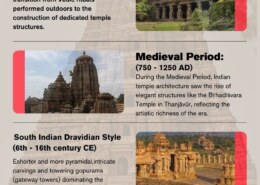Roadmap for Answer Writing Step 1: Introduction (Brief Background) 1. Set the context by providing a brief introduction to temple architecture in India. Temple architecture in ancient India developed in different regions, influenced by dynasties, geography, and cultural aspects. The three primary styles are ...
The Nagar style, prevalent in North India from the 7th to the 12th century, is a distinctive form of Hindu temple architecture. Its architectural features include: Shikhara (Spire): The most prominent feature of Nagar temples is the towering, curvilinear shikhara, which is often intricately adorned.Read more
The Nagar style, prevalent in North India from the 7th to the 12th century, is a distinctive form of Hindu temple architecture. Its architectural features include:
- Shikhara (Spire): The most prominent feature of Nagar temples is the towering, curvilinear shikhara, which is often intricately adorned. The shikhara, rising in a series of diminishing tiers, symbolizes Mount Meru, the axis of the universe in Hindu cosmology.
- Garbhagriha (Sanctum Sanctorum): The central part of the temple, where the main deity’s idol is enshrined. It is usually square or rectangular, with a plain, solid form, emphasizing the sanctity of the deity.
- Mandapa (Pillared Hall): An assembly hall or portico in front of the garbhagriha, often supported by intricately carved pillars. It serves as a space for rituals and congregation.
- Aisles and Inner Walls: The temple complex features a series of subsidiary shrines and surrounding corridors. The inner walls are richly decorated with sculptural reliefs depicting deities, mythological scenes, and intricate patterns.
- Entrance and Torana: The entrance of the temple is elaborately carved, often with a torana (archway) that is decorated with auspicious symbols and divine figures.
- Horizontal Projections: Multiple horizontal projections or projections (like balconies) enhance the temple’s façade and provide aesthetic grandeur.
The Nagar style reflects the rich artistic and religious traditions of medieval North India, with its emphasis on verticality, sculptural detail, and sacred symbolism
See less


Model Answer Introduction In ancient India, temple architecture evolved distinctly across different regions, influenced by the dynasties, geographical terrain, and cultural traditions of the time. The three primary styles of Indian temple architecture are the Nagara, Dravida, and Vesara styles. NagaRead more
Model Answer
Introduction
In ancient India, temple architecture evolved distinctly across different regions, influenced by the dynasties, geographical terrain, and cultural traditions of the time. The three primary styles of Indian temple architecture are the Nagara, Dravida, and Vesara styles.
Nagara Style (Northern India)
The Nagara style is prevalent in northern India, characterized by multiple shikharas (towers) that rise above the temple. The central feature is the Garbhagriha (sanctum), which is located directly beneath the tallest tower. The Mandapa is a large assembly hall used for social and ritual activities. The walls of Nagara temples are often richly decorated on the exterior, though the interiors tend to be more plain. There is no elaborate boundary wall or gopuram (gateway), and these temples usually lack an ambulatory path around the sanctum. Examples of this style include temples from the Odisha school and the Khajuraho school.
Dravida Style (Southern India)
The Dravida style dominates southern India and features a single Vimana (tower) above the sanctum. A distinguishing feature is the presence of Gopurams, which are massive gateways leading into the temple complex, often intricately decorated with sculptures. The Garbhagriha is located at the base of the Vimana, and the temple is usually surrounded by compound walls. Mandapas in Dravida temples are often large, and the interiors are richly adorned with carvings and sculptures. Notable examples include the Shore Temple at Mahabalipuram and Brihadeeswarar Temple in Thanjavur.
Vesara Style (Central India)
The Vesara style is a blend of the Nagara and Dravida styles, found primarily in central India. It combines elements such as a single tower (Vimana) with intricate carvings similar to the Dravida style, but with a layout that sometimes includes a central Mandapa and an Antarala connecting it to the sanctum. One example of this style is the Lad Khan Temple in Aihole.
In conclusion, these temple styles not only reflect the architectural ingenuity of their time but also the cultural diversity of ancient India.
See less